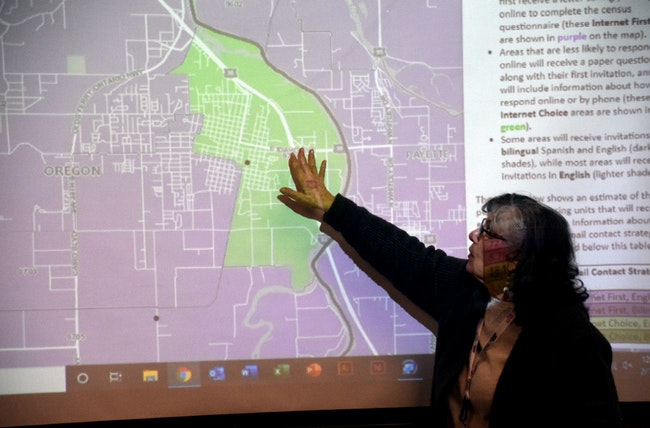
Lynne Gross, partnership specialist in eastern Oregon for the U.S. Census Bureau, gives a presentation at a meeting for the City of Ontario’s Complete Count Committee in 2020. (The Enterprise/Yadira Lopez)
ONTARIO – While nearby counties in Idaho surged in population over the past 10 years, Malheur County held steady, gaining only 258 people over the course of the decade for a total of 31,571 in 2020.
Across the border, Meridian, a Boise suburb, was one of the 10 fastest growing cities in the U.S., according to U.S. Census results released last week.
Population growth as enumerated during the census is important because government funding for certain programs is based on population. The figures also determined the number of U.S. representatives in each state and are used to reset legislative districts.
Local officials said reasons are clear why Idaho has attracted more growth than Malheur County.
“The slow population growth can be attributed to the difference in taxation laws between Oregon and Idaho,” said Peter Hall, assistant city manager of Ontario and former co-chair of the city’s Complete Count Committee. “Idaho is seeing explosive residential growth, but it stops short of Ontario due to the higher property taxes.”
“I think a lot of (stagnation) is because of the lack of housing and jobs,” said Malheur County Commissioner Ron Jacobs.”I suppose (growth) is people that just want to get into a more rural setting.”
Nationwide, the growth of the Latinx population has been one of the biggest trends highlighted by the census. Since 2010, the Latinx population in the U.S. grew 23% to become 19% of the U.S. population.
But in Malheur County, the Latinx population experienced the least growth of anywhere in Oregon, a mere 4.6%.
Even with that slow growth rate, Malheur County is the second-most Latinx county in the state – Latinx people make up 33% of the population. That’s more than anywhere in Oregon except Morrow County, where Latinx people are 41% of the population.
Last year during the census, advocates raised concerns about potential to miss people in the count, especially within the Latinx community. While bilingual census materials were provided to some counties nationwide, Malheur County didn’t receive this benefit because no census tract had high enough percentages of people who would need “Spanish assistance.”
Norma Ramirez, programs manager for Euvalcree, a local nonprofit, said last year that “now that they won’t be receiving the Spanish mailers it’s going to discourage a lot of people.”
“We were particularly concerned about the undercount in Latinx communities because the Trump administration started early in this process to create a dynamic that made it feel unsafe and was tying together immigration status with the census,” said Esperanza Tervalon-Garrett, campaign manager for #WeCountOregon. “That’s not only untrue, but illegal.”
#WeCountOregon was a statewide effort to contact hard-to-count communities using trusted voices. They made calls to all of the counties in Oregon, including Malheur County, in English, Spanish, and several other languages.
Those working with #WeCountOregon confronted the difficulty of contacting rural people and migrant workers. According to Tervalon-Garrett, census forms couldn’t be sent to post office boxes and often weren’t sent to mailboxes that are placed together at the end of a road rather than on individual properties. She also said that census takers typically didn’t go to places housing workers, like trailers or labor camps located on an employer’s property.
Although she qualified her statements by pointing out that the official undercount data for the 2020 census has yet to be released, Tervalon-Garrett said that the way the bilingual census had skipped Malheur County was evidence of a “messed up algorithm” that did not align with the anecdotal knowledge local people have of their communities.
“(Democracy) is only for the people by the people if the people in power are willing to listen to the people,” said Tervalon-Garrett.
Tervalon-Garrett suggested that any undercount of Latinx and people of color in the 2020 census would be political.
“I think that everyone working on the census understood the potential power and impact of counting people of color,” she said.”I think people were afraid of that. Straight up. And I think they’re still afraid of that.”
News tip? Contact reporter Liliana Frankel at [email protected] or 267-981-5577.
For the latest news, follow the Enterprise on Facebook and Twitter.
EXCELLENCE IN JOURNALISM – Available for $5 a month. Subscribe to the digital service of the Enterprise and get the very best in local journalism. We report with care, attention to accuracy, and an unwavering devotion to fairness. Get the kind of news you’ve been looking for – day in and day out from the Enterprise.




